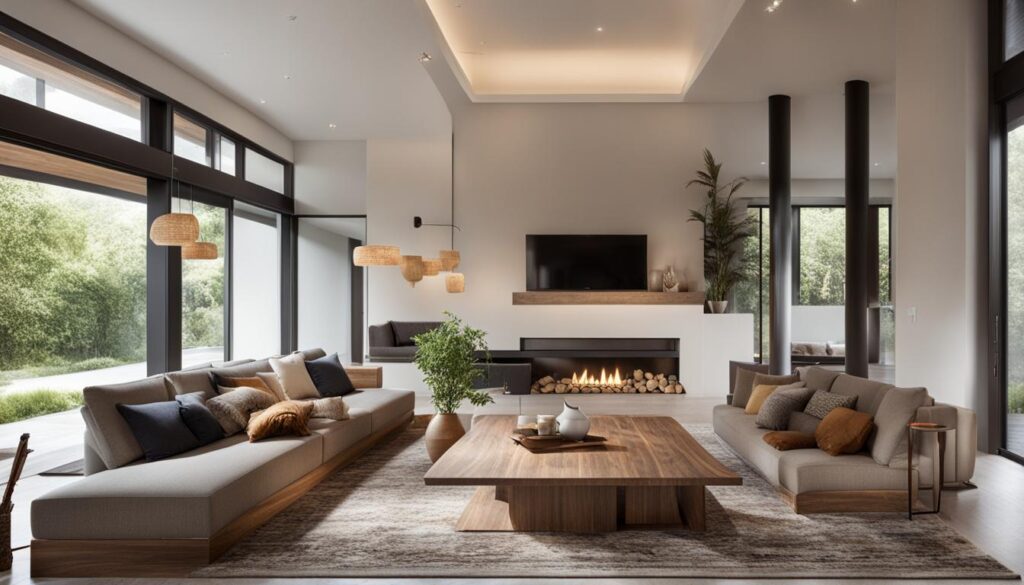When it comes to arranging your living room furniture, the right layout can make all the difference. Whether you have a small space or a large open-concept room, strategically placing your furniture can enhance comfort, functionality, and aesthetics. Here are some expert tips to help you create a well-designed living room:
Table of Contents
Key Takeaways:
- Start with the largest piece of furniture, such as the sofa or armchair, and position it towards the room’s focal point.
- Avoid blocking natural light by placing the sofa in front of a window.
- Incorporate accent furniture like ottomans, coffee tables, end tables, and lamps to add functionality and style.
- Consider arranging furniture away from the walls to create a more open and inviting space.
- Use area rugs to unify seating groups and ensure all key furniture pieces fit on top of the rug.
Tips for Arranging Living Room Furniture
When it comes to arranging your living room furniture, there are several tips to keep in mind. These strategies can help you achieve the best layout that maximizes comfort, functionality, and aesthetic appeal. Whether you have a small or large living room, these tips will help you make the most of your space.
Grant Yourself Flexibility
A key tip for arranging living room furniture is to incorporate lightweight chairs and ottomans that can be easily moved. This allows you to adjust the seating arrangement to accommodate different needs and preferences. With flexible furniture, you can create a more versatile and adaptable space that can easily transition from everyday use to entertaining guests.
Create Balance and Symmetry
Symmetry can bring order and visual appeal to a living room. Consider arranging identical sofas or chairs opposite each other to create a balanced and harmonious look. This layout is particularly effective for formal living rooms or spaces where a sense of symmetry is desired. By placing pieces with the same proportions on both sides of the room, you can achieve a pleasing and cohesive arrangement.
Utilize Area Rugs and Divide the Space
In larger living rooms, using a large area rug can help unify the seating group and create a defined space within the room. Make sure all key furniture pieces can fit on top of the rug for a cohesive and visually appealing look. Additionally, if you have a long or large living room, consider dividing it into two conversation groupings with a clear path between them. This can help create a more intimate and functional space for socializing and relaxation.
| Tips for Arranging Living Room Furniture |
|---|
| Grant Yourself Flexibility |
| Create Balance and Symmetry |
| Utilize Area Rugs and Divide the Space |
Effective Living Room Layouts
When it comes to furniture placement in a small living room, strategic arrangements are key to maximizing space and creating a functional and visually appealing layout. Here are some living room furniture arrangement ideas that can help you make the most of your limited space:
1. Consider the scale: Opt for pieces of furniture that are proportionate to the size of your room. Avoid bulky or oversized furniture that can make the space feel cramped. Instead, choose sleek and streamlined pieces that can fit comfortably in the room without overwhelming it.
2. Utilize wall space: In a small living room, it’s important to utilize vertical space to create storage and display options. Install floating shelves or wall-mounted cabinets to keep clutter off the floor and make the room feel more open. You can also use wall-mounted lighting fixtures to save space on end tables or floor lamps.
3. Create a focal point: Select a focal point in your living room, such as a fireplace, a piece of artwork, or a large window, and arrange your furniture around it. This will not only draw attention to the focal point but also create a sense of balance and harmony in the room.
Arranging living room furniture in a small space can be a challenging task, but with careful planning and strategic placement, you can create a functional, comfortable, and visually pleasing layout. Experiment with different furniture arrangements and don’t be afraid to think outside the box to find the arrangement that works best for your space.
FAQ
Where should I start when arranging my living room furniture?
Start with the largest piece of furniture, such as the sofa or armchair, and position it toward the room’s focal point.
How can I avoid blocking natural light in my living room?
Avoid placing the sofa in front of a window to prevent blocking natural light.
How should I position smaller seating options?
Place smaller seating options opposite or adjacent to the main piece of furniture.
What accent furniture should I consider adding to my living room?
Consider adding ottomans, coffee tables, end tables, and lamps as accent furniture.
How can I create a more open feeling in my living room?
Consider arranging furniture away from the walls to create a more open feeling in the room.
How can I incorporate flexibility into my living room furniture arrangement?
Incorporate lightweight chairs and ottomans that can be easily moved to accommodate different seating needs.
What should I consider when using a large area rug in my living room?
Use a large area rug to unify the seating group within a larger space and ensure that all key pieces of furniture can fit on top of the rug.
How can I divide a long or large living room into two conversation groupings?
Create two conversation groupings with a path between them to divide a long or large living room.
How should I arrange seating for a living room that is frequently used for socializing?
Pull the seating pieces close to the middle of the room, facing each other, and place a coffee table in the center for convenience.
What are the benefits of using a sectional sofa in a living room?
A sectional sofa offers flexible and comfortable seating options, particularly for lounging and TV-watching activities.
How can symmetry be used to bring order to a living room?
Arrange identical sofas or chairs opposite each other to create an attractive balance and bring order to a living room.
How can furniture arrangements be used to divide an open-concept living room?
Use furniture arrangements to create different activity zones, such as a dining area and a conversation area, in an open-concept living room.
How can furniture placement be used to create zones in irregularly shaped rooms?
Use furniture placement and area rugs to create zones in irregularly shaped rooms.
How should I arrange furniture in a long, narrow rectangular living room?
Consider placing the sofa on one long wall and the TV on the opposite wall in a long, narrow rectangular living room.
How should I position seating in relation to the TV in a living room?
Position seating to comfortably view the TV, making sure the TV is free from glare and direct sunlight.
How can I ensure there is enough space between furniture pieces?
Pay attention to traffic flow in the room and ensure there is enough space between furniture pieces.
What type of lighting should I use in my living room?
Use a mix of overhead lighting, floor lamps, and table lamps to create a balanced ambiance in your living room.
How should artwork and mirrors be hung in relation to furniture layout?
Hang artwork and mirrors strategically and proportionally to complement the furniture layout in your living room.
How can I plan ahead for my living room furniture layout?
Use a floor planner or graph paper to sketch out your desired floor plan for your living room furniture arrangement.


